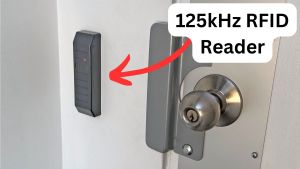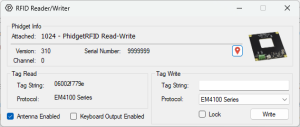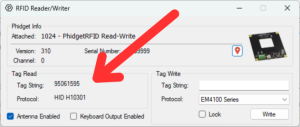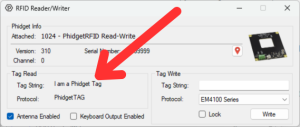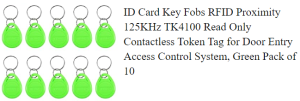RFID Guide
RFID Basics
What is RFID?
RFID stands for Radio Frequency Identification. It is a technology that uses radio waves to identify objects at a distance.
How Does RFID Work?
RFID systems consist of two main components: an RFID reader and an RFID tag.

When an RFID tag is brought close to an RFID reader, the tag is energized and begins transmitting data. The RFID reader can then read this data and perform an action, such as unlocking a door or updating a database.
RFID Tags

RFID tags are small devices consisting of an antenna and an integrated circuit (microchip). They are typically passive, meaning they are unpowered and will only function when energized by an RFID reader.
RFID microchips contain a small amount of non-volatile memory. The tag manufacturer usually preprograms this memory with a unique code or ID. When the microchip is energized, it will broadcast this data using the antenna.
RFID tags come in various shapes and sizes. You have likely encountered them in the form of access cards, key fobs, or wristbands.
Frequencies
RFID tags can be grouped according to their frequencies:
- Low-frequency tags (100-150kHz)—These tags have slower data rates, meaning they are typically less secure and better suited for simple applications such as door access or animal tagging. They may provide a longer read range and better performance near liquids and metals.
- High-frequency tags (13.56MHz)—These tags have faster data rates, allowing them to be used for secure applications like transmitting banking information.
Additionally, ultra-high frequency (UHF) tags exist, although they are less common.
RFID Readers
RFID readers are the active components of an RFID system. They are powered devices that energize any nearby tags. Some RFID readers can also write data to blank or rewriteable RFID tags.
An RFID reader must match the frequency of the tag it is trying to read. For example, if you are using a low-frequency RFID tag, you must use a low-frequency RFID reader.
Phidget RFID Systems
RFID Interfaces
For new systems, the PhidgetRFID Read-Write (1024_1) is recommended.
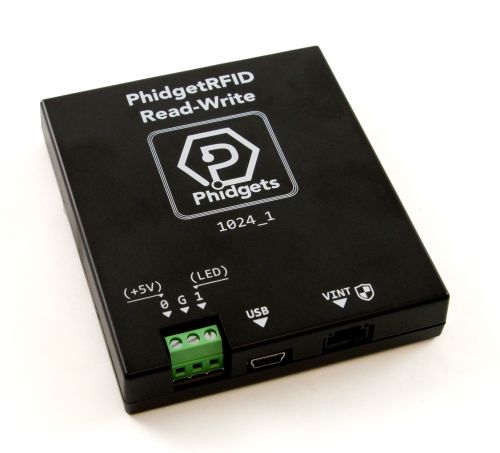
| Operating Frequency | 125 kHz |
| Controlled By | USB or VINT |
| Functionality | Reading and writing low-frequency RFID tags |
Supported Protocols
There are many low-frequency RFID protocols, each dictating how to communicate with specific chipsets. The PhidgetRFID Read Write (1024_1) supports the following low-frequency RFID protocols:
| Protocol | Tag String |
|---|---|
| EM4100 | 10-digit hexadecimal (40-bit) |
| ISO11785 FDX-B | 15-digit numeric |
| H10301 (HID 26-bit/Wiegand) | 8-digit numeric |
| HID Generic | 11-digit hexadecimal (44-bit) |
| PhidgetTag (ASCII) | 24-character plain text |
EM4100
EM4100 is a commonly used low-frequency RFID protocol, originally introduced via the EM4100 chipset.
EM4100 compatible tags feature 64 bits of read-only memory, though only 40 bits are available for encoded data. Phidget RFID interfaces represent this protocol as a 10-digit hexadecimal string (e.g. 0087f3bc91).
ISO11785 FDX-B
ISO11785, in connection with ISO11784, defines low-frequency RFID tags used for animal identification. If you have a cat or dog, they likely have one of these tags implanted. FDX-B refers to the way that the ISO11785 data is encoded on the RFID tag and is the industry-standard encoding scheme.
These tags consist of 64 bits of non-volatile memory. There is a 10-bit ISO 3166 country code and a 38-bit unique ID. Phidget RFID interfaces represents this protocol as a 15-digit decimal with the 3-digit country code leading the 12-digit unique ID. For example, 124000000000123 would represent a Canadian country code and an unique ID of 123. Please note that the 12-digit unique ID cannot exceed the 38-bit maximum integer value of 274,877,906,943.
HID 26-bit (H10301)
Note: This protocol is only supported on the PhidgetRFID Read-Write (1024_1) with firmware version 310 or higher
The HID 26-bit format, often referred to as H10301 or Wiegand, is an open format that is commonly used for access control systems. Phidget RFID interfaces represents this protocol as an eight-digit number with a three-digit facility code and a five-digit card number. The card number is often printed on the card, while the facility code is not.
The facility code is 8-bits, and can support numbers up to 255, and the card number is 16 bits, and supports values up to 65535.
HID Generic
Note: This protocol is only supported on the PhidgetRFID Read-Write (1024_1) with firmware version 310 or higher
HID Global Corporation provides several cards that use proprietary protocols. The raw data from these cards can be read and written, but not intelligently interpreted using a Phidget RFID interface. When a HID tag does not match the 26-bit format, your Phidget RFID interface will read the tag as a HID Generic Tag and will present the 44 raw bits of tag data as an 11-digit hexadecimal string.
This means the 1024_1 can read and copy such tags, but cannot provide any insight on the protocol that would allow you to write new valid tags of the same kind.
PhidgetTAG
The PhidgetTAG protocol is unique to Phidget RFID interfaces. It is useful for users that want plain-text alphanumeric tag strings.
This protocol allows storing an ASCII string, of up to 24 characters (e.g. I am a Phidgets Tag). 7-bit ASCII is supported, including all standard text and control codes. If you have questions about a particular protocol, please contact us for more information.
Supported Chipsets
When shopping for RFID tags online, you will often see the chipset advertised (e.g. Writeable T5577 RFID Tag). The term chipset is used loosely, but generally refers to the microchip present in the RFID tag.
When purchasing read-only RFID tags, you typically do not need to consider the chipset of the RFID tag you are purchasing. Instead, you should simply confirm the protocol is supported by your RFID reader.
When purchasing writable RFID tags, you should confirm the chipset is supported by your RFID interface. The 1024_1 currently supports writing to T5577 and EM4305 tags.
If you have questions about a particular chipset, please contact us for more information.
RFID Tags
Phidgets Inc. stocks a wide variety of read-only and writable low-frequency RFID tags. All tags sold are compatible with Phidget RFID interfaces.
Advanced Topics
Using Multiple RFID Interfaces
Please review this article.
Reading Multiple Tags Simultaneously
Phidget RFID interfaces do not support any anti-collision protocols. This means you will not be able to read more than one tag at a time.


